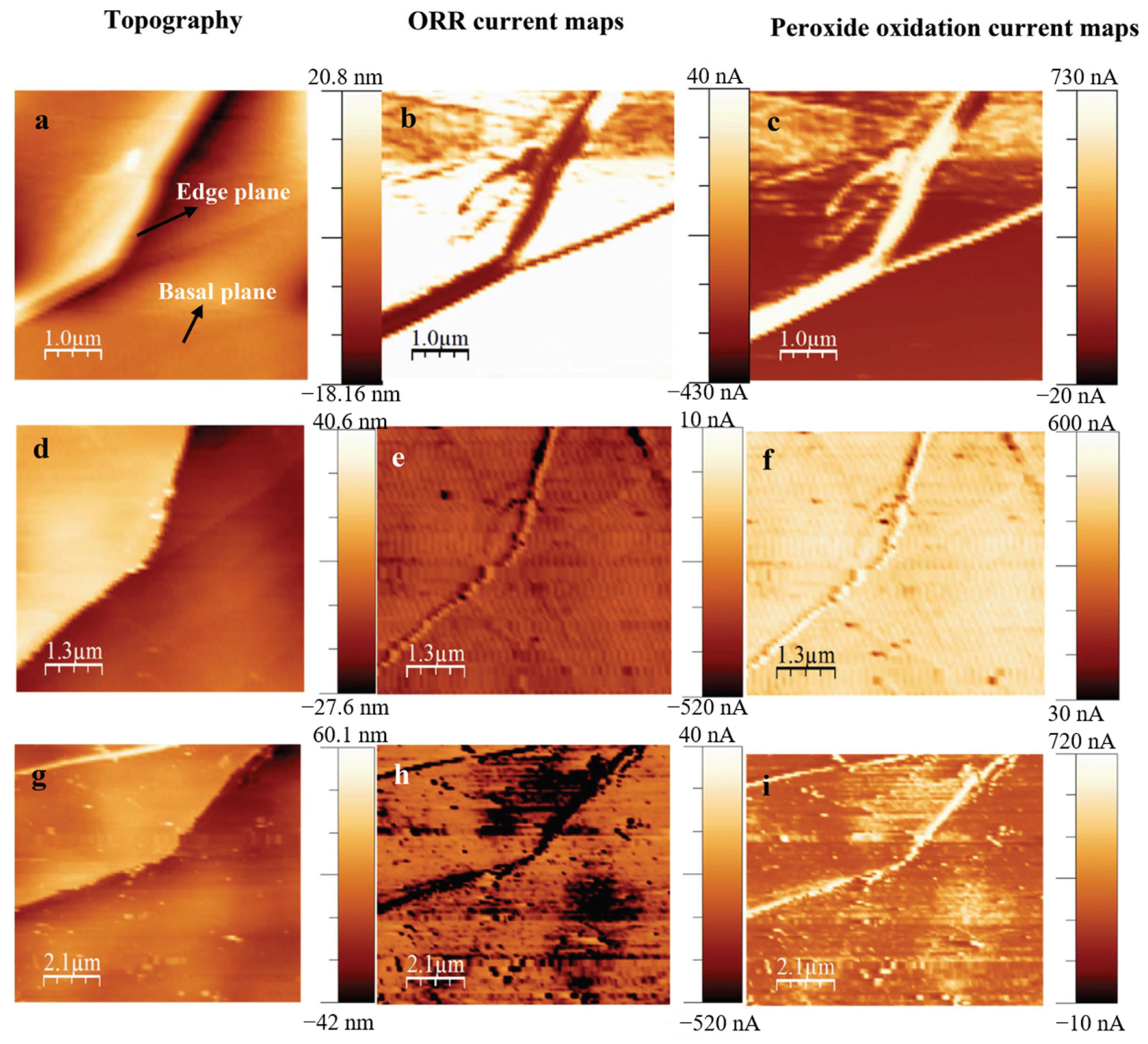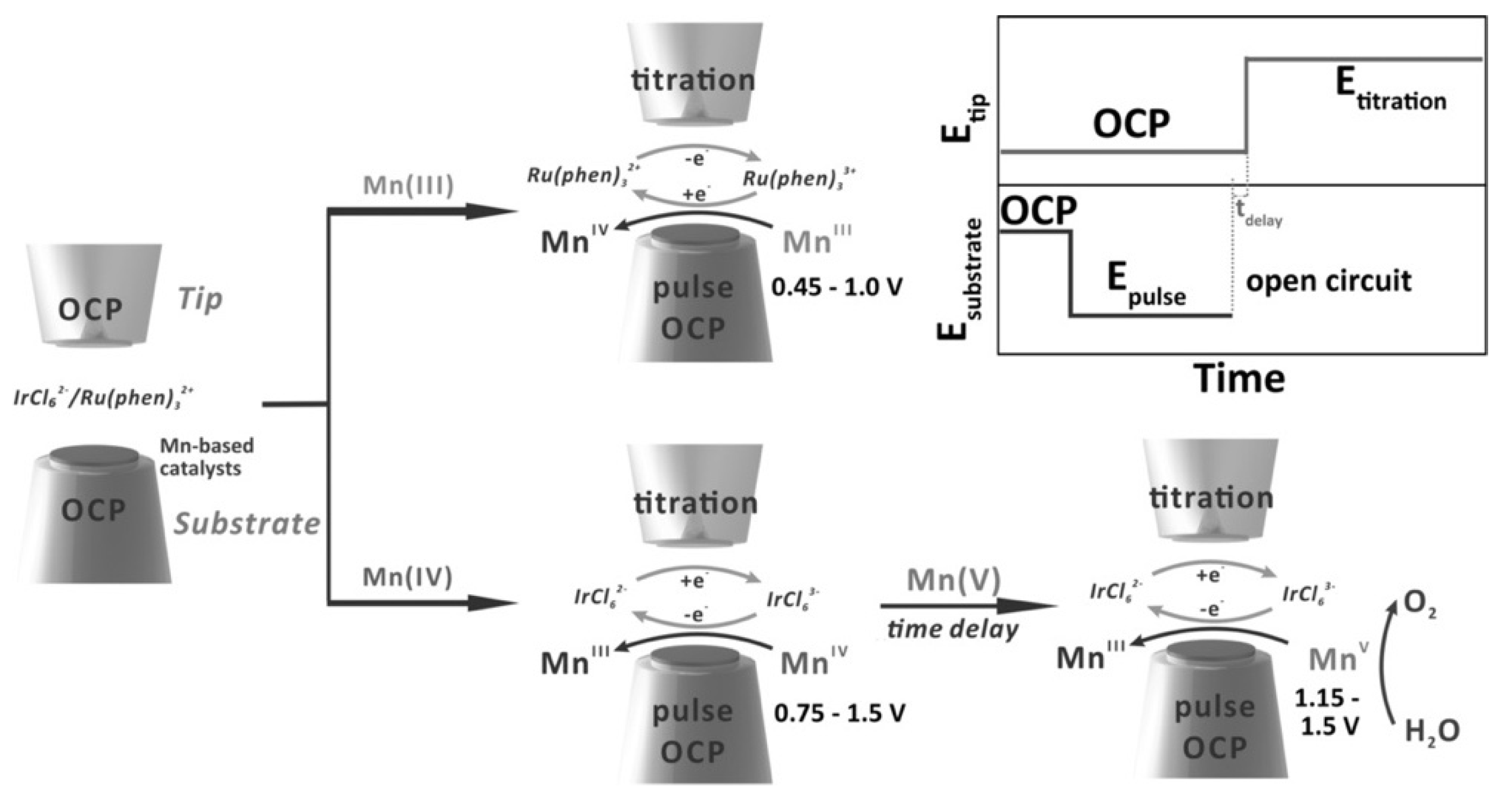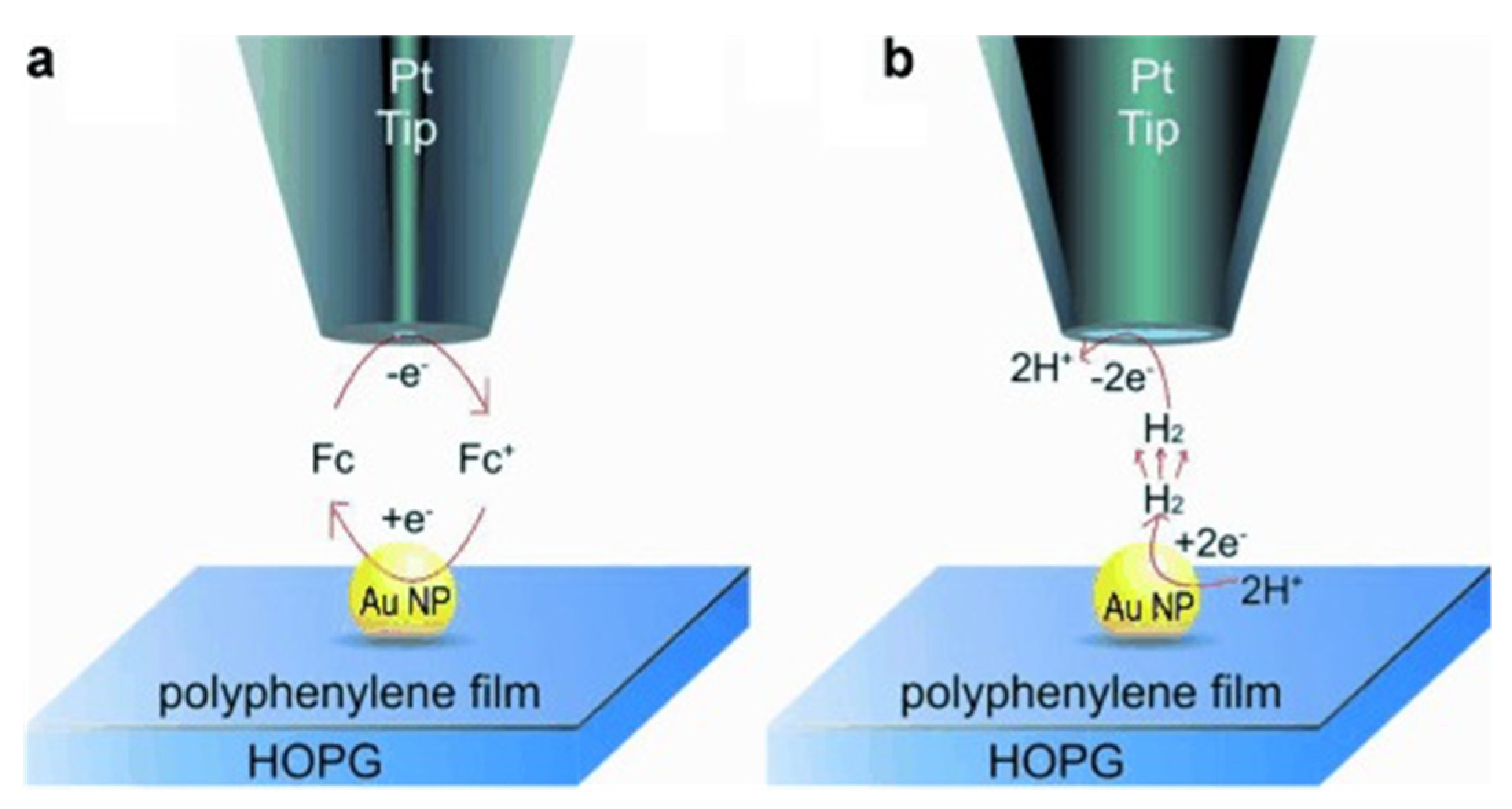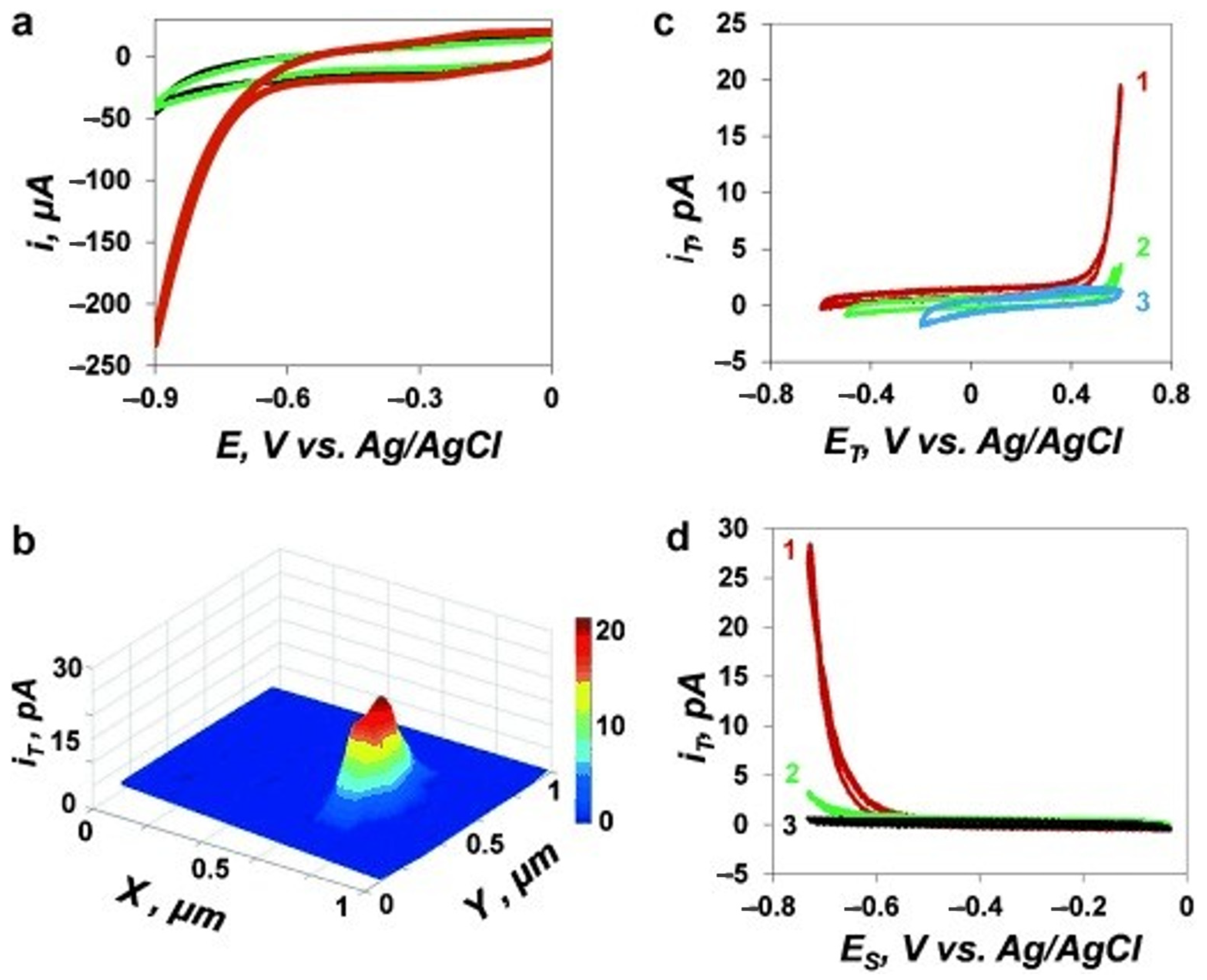1000/1000
Hot
Most Recent

Scanning electrochemical microscopy (SECM) is a powerful scanning probe technique for measuring the in situ electrochemical reactions occurring at various sample interfaces, such as the liquid-liquid, solid-liquid, and liquid-gas. The tip/probe of SECM is usually an ultramicroelectrode (UME) or a nanoelectrode that can move towards or over the sample of interest controlled by a precise motor positioning system. Remarkably, electrocatalysts play a crucial role in addressing the surge in global energy consumption by providing sustainable alternative energy sources. Therefore, the precise measurement of catalytic reactions offers profound insights for designing novel catalysts as well as for enhancing their performance. SECM proves to be an excellent tool for characterization and screening catalysts as the probe can rapidly scan along one direction over the sample array containing a large number of different compositions. These features make SECM more appealing than other conventional methodologies for assessing bulk solutions. SECM can be employed for investigating numerous catalytic reactions including the oxygen reduction reaction (ORR), oxygen evolution reaction (OER), hydrogen evolution reaction (HER), water oxidation, glucose oxidation reaction (GOR), and CO2 reduction reaction (CO2RR) with high spatial resolution. Moreover, for improving the catalyst design, several SECM modes can be applied based on the catalytic reactions under evaluation.
Advances in electrochemical technologies have played a crucial role in gaining deeper insights into the electrochemical reactions occurring at solid-liquid, liquid-liquid as well as liquid-gas interfaces [1][2][3]. Electrochemical techniques have gained worldwide interest over the recent years as they offer an efficient platform to study the renewable and sustainable energy generation arising from various electrocatalytic chemical reactions, such as photoelectrochemical (PEC) splitting of water, the electrochemical production of H2O2, the electroreduction of CO2, glucose-based biofuel cells (GFCs) for assessing electrocatalytic glucose oxidation, and water splitting reactions [4][5][6][7][8][9][10].
Scanning probe microscopy (SPM) techniques, especially scanning electrochemical microscopy (SECM), can be utilized for the screening of a large number of electrocatalysts and instantaneous in-situ product analysis [11][12]. SECM comprises of an ultramicroelectrode (UME) or a nanoelectrode (NE) acting as the probe (depending on the sample sizes) that enables the efficient mapping of localized electrochemical activity over various homogeneous and heterogeneous surfaces [13][14]. The catalytic reactions may occur heterogeneously on the sample surfaces, and thus SECM can be used to understand the reaction sites, nature of spatial variations, and reaction dynamics of the catalytic systems. Table 1 summarizes the recent advances of SECM for evaluating catalysts. For instance, SECM can measure a variety of localized catalytic redox reactions, including oxygen reduction reaction (ORR) [15][16][17], oxygen evolution reaction (OER) [18][19], hydrogen evolution reaction (HER) [15][20][21][22], water oxidation [23], glucose oxidation reaction (GOR) [24][25], and CO2 reduction reaction (CO2RR) [26][27]. Furthermore, SECM can be employed for the determination of short-lived intermediates (such as CO2−) [28].
Table 1.Recent advances in the applications of SECM for assessing catalysts.
| Instrumentation | Material of the Probe | Mode | Catalysts | Catalytic Reaction | References |
|---|---|---|---|---|---|
| SECM | Pt | RC | PdW nanoparticles supported on nitrogen and sulfur co-doped graphene (NSG) | ORR | [29] |
| SECM | Au | SG/TC | Nanowires of silver chloride and bromide (AgClNWs and AgBrNWs) | ORR | [30] |
| SECM | Pt | RC | Octahedral cobalt sulfide (CoS2) | ORR | [31] |
| SECM | Pt | RC | Manganese tungstate (MnWO4) | ORR | [32] |
| AFM-SECM | Pt | SG/TC; Direct mode |
Fe–N doped planar graphite | ORR; H2O2 production | [16] |
| SECM | Pt | SG/TC | nickel and cobalt-based oxides (NiO, Co3O4 and NixCo3-xO4) |
HO2− production in ORR | [9] |
| SECM | Au | FB | Copper nanostructures (CuNSs) |
ORR and CO2 reduction | [33] |
| SECM | Cu and Fe | TG/SC | Copper | ORR; HER; CO2RR | [34] |
| SECM | Pt | SG/TC; RC |
Nitrogen-bearing carbon spheres (NCSs) | ORR; H2O2 production | [35] |
| SECM | Pt | RC | Nanostructured hybrids based on MoSe2 on reduced graphene oxide (rGO) nanosheets |
ORR | [36] |
| SECM | Pt | SG/TC; TG/SC; RC |
Multiwalled Carbon nanotubes (MWCNTs) with cobalt(IX) protoporphyrin (MWCNTs/CoP) |
ORR; H2O2 production | [37] |
| SECM | Pt | RC | ZnCo2O4 on carbon nanotubes (ZnCo2O4/CNTs) and Pt/C | ORR | [38] |
| AFM-SECM | Au-c-Pt tip | SG/TC | Platinum nanoparticles (Pt NPs) |
ORR; H2O2 production | [39] |
| SECM-SICM | Pt coated pyrolytic carbon | SG/TC; RC |
Gold nanoparticles (Au NPs) |
ORR; H2O2 generation | [40] |
| Raman-SECM | Glassy carbon | SG/TC | Lithium intercalated nickel phosphorus trisulfide (NiPS3) | OER | [41] |
| SI-SECM | Au | FB | CoPi nanosheets | Water oxidation, OER | [23] |
| Raman-SECM | Pt | SG/TC | Ni/Fe and Ni thin films | OER | [42] |
| SECM | Pt | SG/TC | reduced graphene oxide supported ZnCo2O4 microsphere (rGO-ZnCo2O4) |
ORR; OER | [43] |
| SECM | Pt | SG/TC | Cobalt-based metalloids (CoxB and CoxP) composites |
ORR, OER; | [44] |
| SECM | Pt | SG/TC | Mesoporous single-atom-doped graphene–carbon nanotube hybrid | ORR; OER | [45] |
| SECM | Pt | SG/TC; FB | MXenes (2D early transition metal carbide) |
HER | [21] |
| SECM | Pt | SG/TC | Iron sulfide (FeS2) nanostructures (1D, wires and 2D, discs) | HER | [46] |
| SECM | Pt | SG/TC | Metal-organic frameworks (CoSx MOFs) |
HER | [15] |
| SECM | Pt | SG/TC | Sulfur vacancies on Molybdenum disulfide (SV-MoS2) | HER | [47] |
| SECM | Pt | FB; SG/TC |
Mixed-phase MoS2 nanosheets | HER | [48] |
| SECM | Pt | SG/TC | Ni and Ni/α-Ni(OH)2 heterostructures | HER, OER | [49] |
| SECM | Pt | SG/TC | Decamethylruthenocene (DMRc) in 1,2-dichloroethane/water (DCE|W) biphasic system | HER | [50] |
| SECM | Carbon; Pt | FB; SG/TC |
Silver nanoparticles (Ag NPs) and silver nanoclusters (Ag NCs) on multi-wall carbon nanotubes (MWCNT) | Bicarbonate reduction | [51] |
| SECM | Hg/Pt | TG/SC | Au metal surface | Intermediate of CO2 reduction | [52] |
Depending on the type of electrocatalysis and catalyst used, SECM can operate via various working modes, such as substrate-generation/tip-collection (SG/TC) mode, tip-generation/sample-collection (TG/SC) mode, feedback (FB) mode, redox competition (RC) mode, and direct mode. SECM acts as an ideal tool for assessing the catalytic/electrocatalytic reactions as well as for determining the catalytic efficiency of electrocatalysts based on numerous features, including the electron transfer mechanism, oxidation potential, current density, surface morphology, electronic band structures, porosity, tunability, and availability of active edge sites [11]. High-precision and real-time monitoring of localized catalytic electrochemical reactions can provide a remedy to numerous biotechnological problems such as corrosion of polymers and carbon-based materials, the decay of biofuel cells, etc. [11][12]. The understanding of these chemical reactions may accelerate the development of new technologies and guide the scientists to conduct more precise research [53][54].
In order to gain insights into the reactions occurring at the surface of these nanomaterials, the scanning electrochemical microscopy-atomic force microscopy (SECM-AFM) was used to map the catalytic currents with ultra-high resolution (around 50 nm). Figure 1 demonstrates that the combination of SECM and AFM can reveal the Fe-coordinated nitrogen sites formed both in the edge as well as basal planes of highly ordered pyrolytic graphite (HOPG) and meanwhile, provides the topographical information on a nanometric scale. The Kolagatla group compared the HOPG surface with ammonia plasma-treated HOPG (N-HOPG), and iron and ammonia plasma-treated HOPG (Fe-N-HOPG) surfaces. They demonstrated that the edge planes of Fe-N-HOPG have enhanced catalytically active sites as compared to other tested surfaces, as the catalytic activity of the ORR in acidic solution arises mainly through the Fe coordinated ‘N’ sites, associated with structural defects in the HOPG surface [16]. This system enables a deeper understanding of the catalytic sites on different composites and thus, paves a way for a better design of the catalysts.

Figure 1. The AFM topography scan, oxygen reduction and peroxide oxidation current mapping images (in this order) of HOPG (a–c), N-HOPG (d–f), and Fe-N-HOPG (g–i), respectively. The applied substrate potentials for the oxygen reduction current mapping are 0.68 V (HOPG and N-HOPG) and 0.7 V (Fe-N-HOPG). The applied tip potential for the hydrogen peroxide oxidation current mapping is 1.2 V. The SECM-AFM tip scan rate used for the current-mapping experiments is 15 ms per point; (1 ms per point = 4 nm ms−1) [16].
The oxygen evolution reaction (OER) is the process of generating oxygen molecules through a chemical reaction. Oxygen molecules can be generated from the electrolysis of water, oxidation of water during oxygenic photosynthesis, or electrocatalytic oxygen evolution reactions [12][19][41][42][43][45][49][55]. In the fields related to metal-air batteries and solar fuel production or other renewable energy technologies, the catalysts for the OER reaction are usually composed of manganese oxides (MnO), ruthenium, iridium oxides, and other first-row metals; however, they are costly and rare [55].
SECM can reveal the OER status in real-time and provide useful information on the reaction rate. In a recent study of OER, Bard’s group used surface interrogation scanning electrochemical microscopy (SI-SECM) to investigate manganese oxidation state on the two electrodeposited manganese-based electrocatalysts, amorphous MnOx, and perovskite CaMnO3. The workflow of the detection of the different manganese oxidation states on the two catalysts is presented in Figure 2. The intermediates of the OER process were generated by giving a voltage pulse on the substrate from the open circuit potential (OCP) to a certain potential for several seconds [19]. Consequently, the SECM probe enhanced the production of redox species that titrates adsorbed molecules on the substrate. During the OER process, MnV species were identified in both electrocatalysts by analyzing the feedback currents and finally, the reaction rates calculated. Besides, the Bron group coupled Raman spectroscopy with SECM and demonstrated that in situ Raman-SECM can be utilized for mapping the OER activity of electrochemically deposited Ni and Ni/Fe thin-film electrodes in an alkaline media. This in situ spectroelectrochemical methodology can provide clearer insights into the structure, structural changes, and resulting catalytic activity of NiFe oxides/hydroxides using Raman spectroscopy as well as simultaneously assess the onset of OER using SECM in SG/TC mode at the same location [42].

Figure 2. A systematic methodology for SI-SECM. The oxidation and reduction titrations were performed in two separate ways: one for Mn(III) using the redox titrant Ru(phen)32+/3+, and another for Mn(IV) as well as Mn(V) using IrCl62−/3−. Reprinted from ref. [19]. Copyright 2020, John Wiley and Sons [19].
Hydrogen is a promising alternative energy source that is more environmentally friendly and renewable. Therefore, the development of electrocatalysts for the hydrogen evolution reaction (HER) is an important concern. Typically, catalysts for HER reaction are composed of noble metals. In recent years, SECM has been used for screening earth-abundant electrocatalysts, so the design of active non-precious metal-based catalysts can be improved.
Recently, single-atom catalysts (SACs) with the atomic distribution of metal active sites attracted great attention because of their extraordinary features of high reactivity. The characterization of SACs and the unveiling of catalytic mechanisms on individual sites can be done by the SECM [56]. However, the scanning of a single molecule or single nanoparticle catalysts is relatively feasible. Figure 3 presents that Mirkin’s group revealed the HER reaction occurs on a single Au nanoparticle on a polyphenylene film. The current distribution in the SECM image under SG/TC mode reflects the catalytic site of the nanoparticle (Figure 4).

Figure 3. Illustration for SECM being operated on individual Au NPs via: (a) feedback (FB) mode, and (b) SG/TC mode. Reprinted from ref. [57]. Copyright 2014, John Wiley and Sons [58].

Figure 4. Voltammetric and SECM analysis for assessing the HER activity at gold nanoparticles (AuNPs). (a) Voltammograms corresponding to the reduction of protons at uncoated-HOPG (black), polyphenylene-coated HOPG (green), and 20-nm-gold nanoparticles (AuNPs) immobilized onto the modified HOPG (red). (b) SG/TC map corresponding to the HER activity at an individual 20-nm-gold nanoparticles acquired using a 15 nm-radius Pt tip. ET = 500 mV, ES = −750 mV vs. Ag/AgCl. (c) Voltammograms obtained at a 60 nm-radius Pt tip kept above the AuNP, 80 nm apart from the modified HOPG surface. ET was scanned, and ES (in mV) was −600 (1), −500 (2), and −100 (3). (d) Tip/substrate voltammograms were acquired at the same position as in (c). ES was scanned, and ET (in mV) was 500 (1), 400 (2), and 100 (3). The electrolyte solution comprised 10 mM HClO4 and 0.1 M NaClO4. The potential sweep rate was 100 mV s−1. Reprinted from ref. [58]. Copyright 2014, John Wiley and Sons.
Moreover, novel catalysts such as metal-organic frameworks (MOF) were explored, and the HER mechanism was also interpreted by SECM. The Hod group developed the electrochemically converted-MOFs (termed “EC-MOFs”) into highly active electrocatalysts and optimized their conversion parameters (scan rate, potential range, and number of potential scans) for enhancing their electrochemical performance. They employed SECM in SG-TC mode to map in situ HER activity of the EC-MOF of ZIF-67 into patterned CoSx, an HER electrocatalyst. Furthermore, they also performed in situ OER analysis of a bi-metallic (Fe,Ni)-MIL-53 MOF into patterned FeNiSx, revealing that SECM can serve as a useful technique for optimization of localized catalyst fabrication as well as for designing MOF-based patterned arrays for electrochemical studies [15].
In addition to the reactions mentioned above, other catalytic reactions including CO2 reduction, hydrogen peroxide production, and water oxidation, have been investigated by SECM. For instance, various methods for the elimination of greenhouse gases include energy-driven CO2 reduction, photothermal, thermal-catalytic, and artificial photosynthesis. Catalysts used for CO2 reduction reactions determine the efficiency of the conversion of CO2 toward high-value hydrocarbons [23][26][27][59].